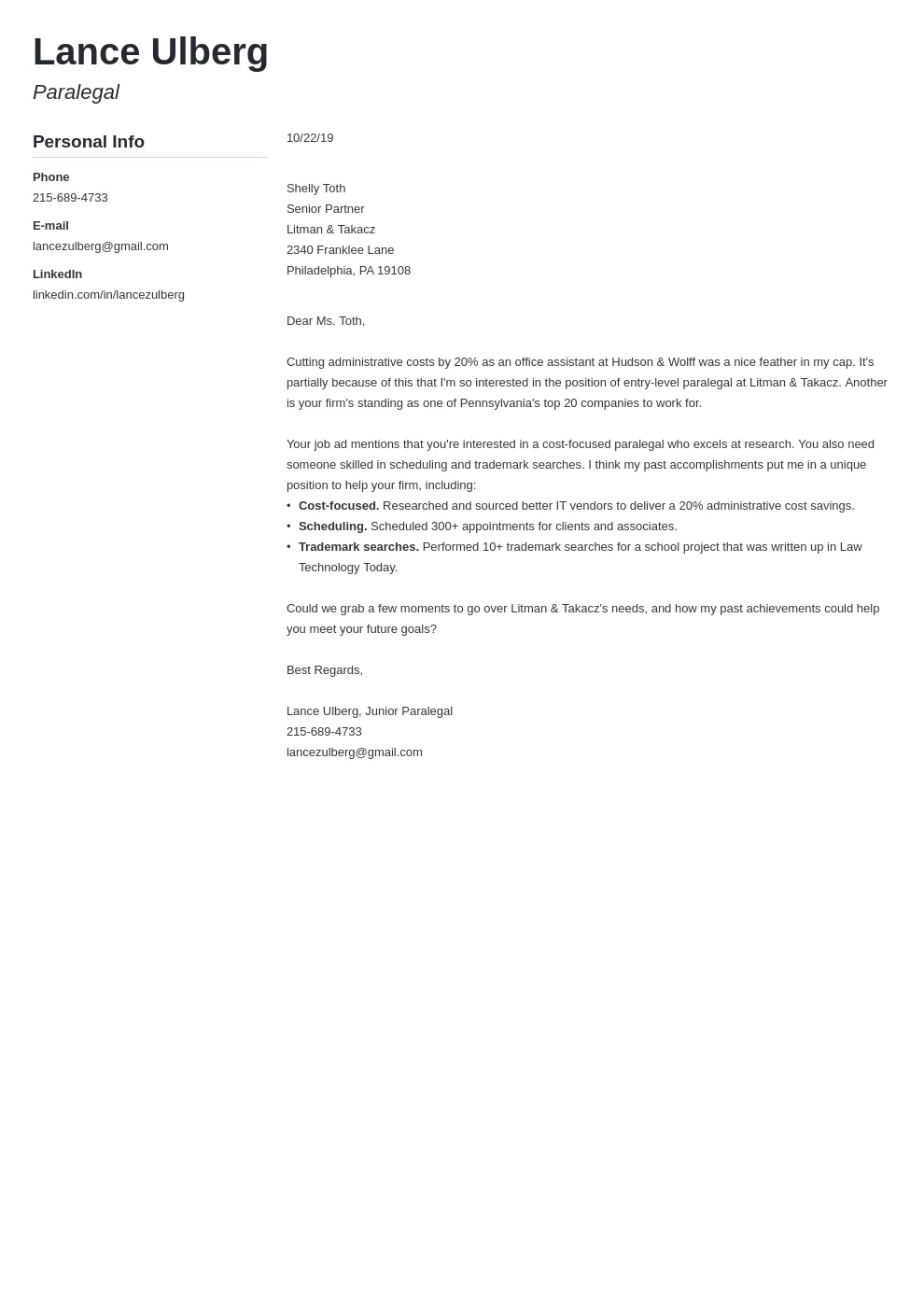What is a Paralegal Cover Letter
A paralegal cover letter is a crucial document that accompanies your resume when applying for paralegal positions. It serves as your introduction to a potential employer, offering a glimpse into your skills, experience, and suitability for the role. Unlike your resume, which provides a factual overview of your qualifications, a cover letter allows you to showcase your personality, express your enthusiasm, and explain why you’re the perfect fit for the specific job and the law firm. A well-crafted cover letter can significantly increase your chances of landing an interview, making it an essential part of any paralegal job application strategy. Crafting a compelling cover letter requires careful attention to detail, tailoring, and a clear understanding of what employers seek in a paralegal candidate. The goal is to make a strong first impression and persuade the hiring manager to learn more about you.
The Importance of a Paralegal Cover Letter
The importance of a paralegal cover letter cannot be overstated, as it’s often the first impression you make on a potential employer. It gives you the opportunity to go beyond the basic facts presented in your resume and to connect with the hiring manager on a personal level. A cover letter allows you to highlight specific skills and experiences that directly align with the job requirements, demonstrating your understanding of the role and your enthusiasm for the position. It’s also your chance to explain any gaps in your resume or career transitions, and to showcase your communication skills and writing ability, which are essential for any paralegal. In a competitive job market, a well-written cover letter can set you apart from other applicants, showcasing your attention to detail, professionalism, and genuine interest in the opportunity. Ignoring a cover letter or submitting a generic one can send a signal that you lack attention to detail or are not truly invested in the position.
Key Components of a Paralegal Cover Letter

A well-structured paralegal cover letter follows a standard format, ensuring clarity and professionalism. Each section plays a vital role in conveying your qualifications and interest. Begin with the header, including your contact information, followed by the date, and the recipient’s details. The body of your cover letter should be divided into three or four paragraphs. The first paragraph introduces you and states the position you’re applying for, while the subsequent paragraphs highlight relevant skills and experiences, emphasizing your qualifications. The closing paragraph summarizes your interest, expresses gratitude for the opportunity, and includes a call to action. Throughout the letter, maintain a professional tone, demonstrate strong writing skills, and tailor the content to the specific job description. Remember, the cover letter is your chance to make a lasting impression.
Header Information
Your header is the first thing the hiring manager will see, so it’s crucial to present it professionally. Start with your full name, followed by your address, phone number, and email address. This information should be aligned to the left or right of the page. Choose a font that is easy to read, such as Arial, Times New Roman, or Calibri, and maintain a consistent font size (typically 10-12 points) throughout the entire document. Using a clean and simple design for your header makes it easy for the recruiter to quickly access your contact details. Ensuring your contact information is accurate is essential; double-check your email address and phone number to avoid any missed communication. Accuracy and neatness in your header set a professional tone, demonstrating your attention to detail from the start.
Applicant’s Contact Information
Begin by listing your full name at the top of the header. Following this, provide your complete mailing address, ensuring it’s up-to-date and accurate. Include your phone number, using a professional format (e.g., (555) 123-4567), and make sure your voicemail is set up and ready to receive messages. Next, include your email address. It’s highly recommended to use a professional-sounding email address (e.g., yourname@email.com) rather than a casual one. Double-check that the email address is correct to avoid any missed communications. These details need to be clear and easily accessible so the hiring manager can quickly reach you for further steps in the hiring process. Correct and easily readable contact details show you pay attention to detail.
Date
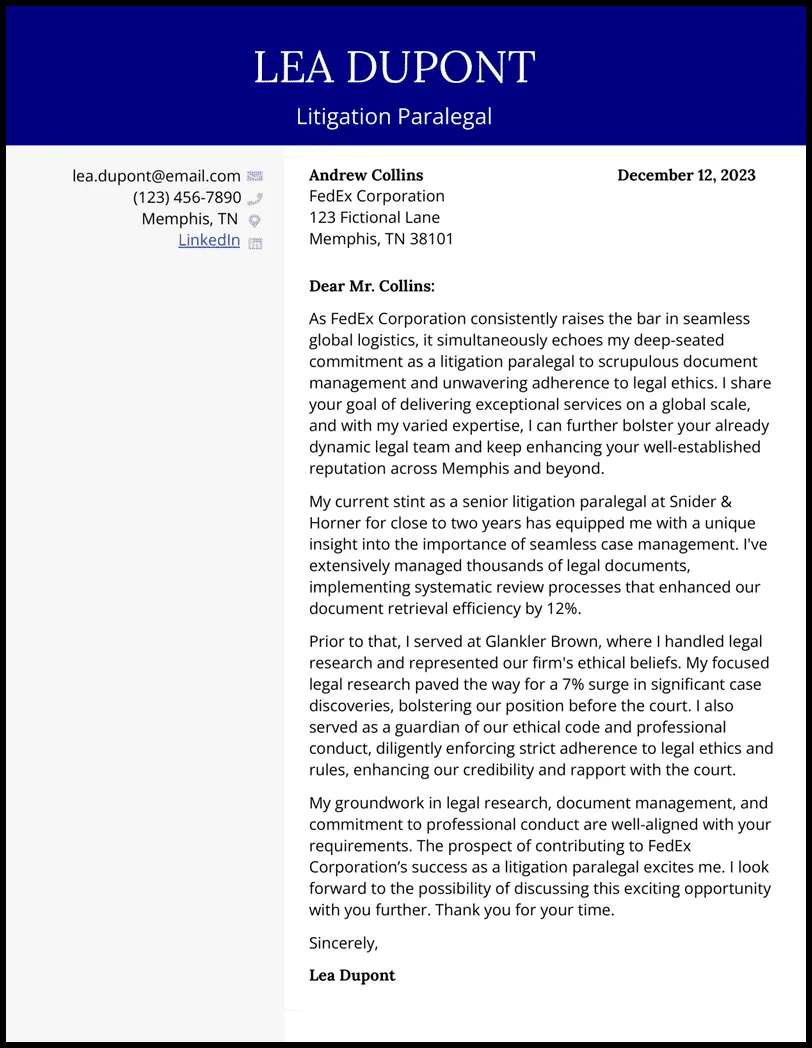
The date on your cover letter should be the date you are submitting your application. It is important to include the current date to indicate when the letter was written and sent. Format the date correctly, using the standard format appropriate for your location (e.g., Month Day, Year). Place the date directly beneath your contact information and slightly above the recipient’s details. This positioning ensures that the date is clearly visible and organized within the overall structure of the letter. Accurate dating helps the employer understand when you submitted your application and keep track of the application timeline. Including the date shows attention to detail and helps maintain a professional appearance, which is essential for any paralegal job application. Ensure the date is up-to-date to avoid any confusion.
Recipient’s Contact Information
Directly below the date, include the recipient’s contact information. If you know the hiring manager’s name, use it; address the letter to them personally (e.g., ‘Dear Ms. Smith’). If you don’t know the name, research the firm’s website or use a professional salutation like ‘Dear Hiring Manager.’ Include the recipient’s title, company name, and full address. This demonstrates that you’ve taken the initiative to personalize the letter and tailor it to the specific employer. Double-check all details for accuracy; ensure the company name and address are correct to avoid any errors. Personalized addressing shows professionalism and that you care about the position. It’s important to research and find the most accurate contact details available to show you’ve done your homework.
Professional Salutation
The salutation is your initial greeting to the hiring manager, and it sets the tone for the rest of your letter. Start with a formal greeting, such as ‘Dear Mr./Ms./Mx. [Last Name]’ if you know the hiring manager’s name. Using a person’s name demonstrates that you have done your research and are invested in the position. If you are unsure of the hiring manager’s name, use a professional alternative, such as ‘Dear Hiring Manager’ or ‘Dear [Law Firm Name] Hiring Team.’ Avoid casual greetings like ‘Hi’ or ‘Hello.’ Always end the salutation with a colon (:), not a comma, to maintain a formal tone. A professional salutation is crucial as it sets a positive tone from the beginning. Make sure to address the correct person and use an appropriate and respectful tone.
Body Paragraphs
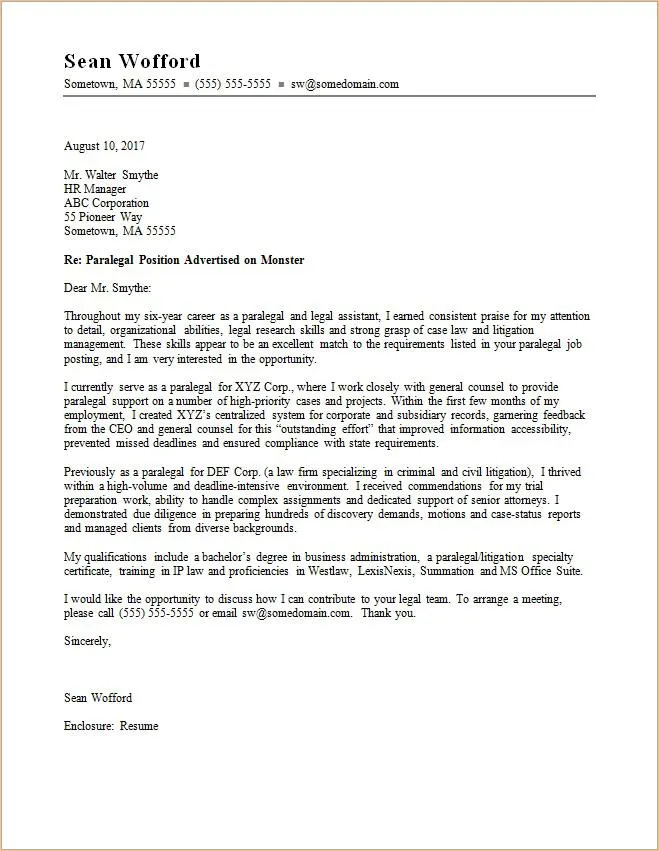
The body paragraphs are the core of your paralegal cover letter, where you showcase your qualifications and express your interest in the position. Each paragraph should serve a specific purpose, guiding the reader through your relevant skills and experience. The first paragraph should introduce you and state the specific position you’re applying for. The subsequent paragraphs delve into your qualifications, highlighting the skills and experiences that align with the job requirements. Use the job description as a guide, tailoring your examples to the employer’s needs. The final paragraph should reiterate your interest in the position, express your gratitude for the opportunity, and include a call to action, such as stating that you are available for an interview. Maintaining a clear and logical flow within the body paragraphs is key to effectively conveying your message and making a strong impression. Proper organization allows the reader to easily understand your value.
First Paragraph: Introduction
The first paragraph of your cover letter is your opportunity to make a strong first impression. Start by stating the specific paralegal position you’re applying for and where you saw the job posting. Then, provide a brief overview of your experience and qualifications, highlighting a few key skills or experiences that make you a strong candidate. Express your enthusiasm for the role and the law firm. The introduction should capture the reader’s attention and entice them to continue reading. Keep it concise and focused, aiming to provide a snapshot of your relevant experience and interest. This initial paragraph sets the stage for the rest of your letter. Be sure to quickly demonstrate your understanding of the job requirements.
Highlighting Relevant Experience
In your body paragraphs, provide specific examples of your relevant experience. Instead of simply listing your job duties, focus on how your skills and experiences align with the requirements of the paralegal position. Describe situations where you successfully managed tasks, such as legal research, drafting documents, or client communication. Use the STAR method (Situation, Task, Action, Result) to structure your examples, demonstrating how you handled challenges and achieved positive outcomes. Quantify your achievements whenever possible, providing concrete data to support your claims. Tailoring the examples to the specific job description shows your understanding of the role. Showing results is more convincing than simply stating your experience. This helps the hiring manager understand your capabilities.
Showcasing Skills and Qualifications
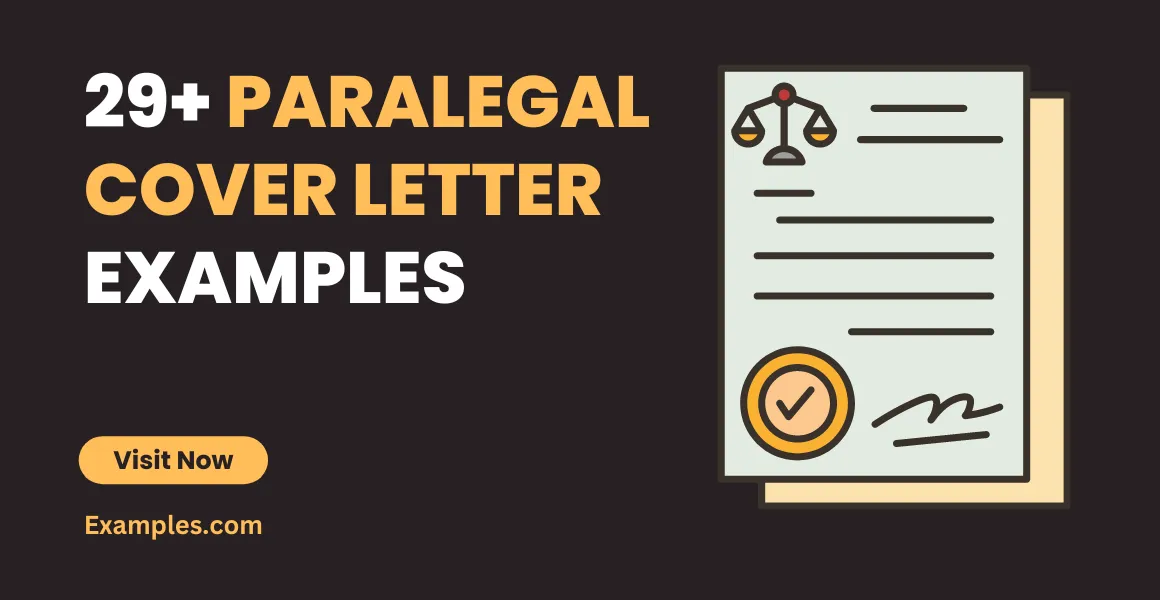
Beyond your experience, highlight the specific skills and qualifications that make you an ideal paralegal candidate. Refer to the job description and identify the key skills the employer is seeking. Provide examples of how you’ve utilized those skills in previous roles. For example, if the job requires strong research skills, describe instances where you successfully conducted legal research and analyzed findings. If the position emphasizes attention to detail, provide examples of your meticulousness in drafting documents or managing files. Emphasize your proficiency in relevant software, such as legal research databases, document management systems, and case management software. Matching your skills to the job requirements will showcase your suitability for the role. This targeted approach will help convince the hiring manager that you possess the skills needed to succeed in the paralegal position.
Second Paragraph: Skills and Qualifications
The second paragraph should delve deeper into your skills and qualifications, providing specific examples to support your claims. Begin by identifying a few key skills or qualifications that are essential for the paralegal position, such as legal research, document drafting, or client communication. Then, provide detailed examples of how you’ve demonstrated these skills in previous roles. Describe the situations, tasks, actions, and results (STAR method) to provide context and demonstrate your capabilities. Quantify your achievements whenever possible. This could involve the number of documents drafted, cases researched, or clients supported. The goal is to give the hiring manager concrete evidence of your ability to perform the duties of the paralegal role. Showing examples is essential to backing up your claims and proving your abilities.
Quantifiable Achievements
Quantifying your achievements is an effective way to demonstrate your value to a potential employer. Instead of simply stating that you have experience, use numbers and data to showcase the impact of your work. For example, instead of writing ‘Managed a large caseload,’ write ‘Managed a caseload of over 50 cases, consistently meeting deadlines and achieving a high success rate.’ Use metrics such as the number of documents drafted, cases researched, or clients supported. If you improved efficiency or reduced costs, include those figures. Quantifiable achievements give the hiring manager concrete evidence of your capabilities and make your accomplishments more impressive. This is essential as it allows the hiring manager to understand your real-world impact.
Demonstrating Legal Knowledge
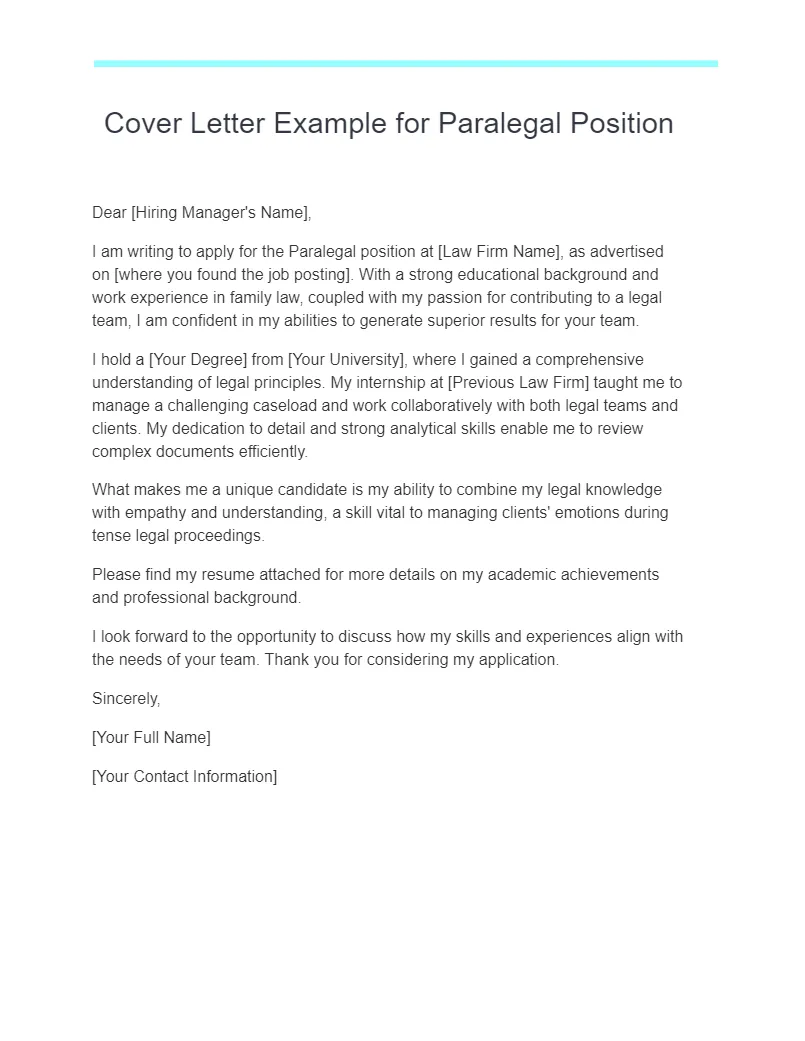
Demonstrate your legal knowledge throughout your cover letter. Showcase your familiarity with legal terminology, legal procedures, and relevant laws. Provide examples of how you’ve applied your legal knowledge in previous roles, such as conducting legal research, drafting legal documents, or assisting in case preparation. If you have specialized knowledge in a particular area of law, such as corporate law, intellectual property law, or litigation, be sure to mention it, especially if it aligns with the job requirements. Even if you do not have extensive experience, showcasing your understanding of legal principles and your ability to learn and adapt is key. This demonstrates that you are well-versed in the field and prepared to contribute to the law firm’s success.
Third Paragraph: Enthusiasm and Fit
The third paragraph allows you to express your enthusiasm for the position and explain why you’re a good fit for the law firm. Briefly reiterate your interest in the specific role and the organization. Showcase your knowledge of the firm’s mission, values, and areas of practice. Explain how your skills and experience align with their needs and how you can contribute to their success. Mention any personal qualities that would make you a valuable team member. This is your chance to show that you have researched the firm and are genuinely interested in working there. Demonstrating genuine interest makes you stand out from other applicants. A well-crafted third paragraph can leave a lasting impression on the hiring manager.
Expressing Interest in the Position
In your cover letter, clearly express your interest in the specific paralegal position and the law firm. Avoid generic statements and instead, tailor your message to the job and the organization. Briefly reiterate why you are excited about the opportunity, highlighting aspects of the role that particularly appeal to you. If possible, mention specific projects or areas of law that align with your interests and skills. Show that you have researched the firm and understand their values and goals. Your enthusiasm should be genuine and reflect your sincere desire to join their team. This helps the hiring manager see you as more than just a candidate. Expressing enthusiasm demonstrates a strong desire to succeed in the paralegal role.
Researching the Law Firm
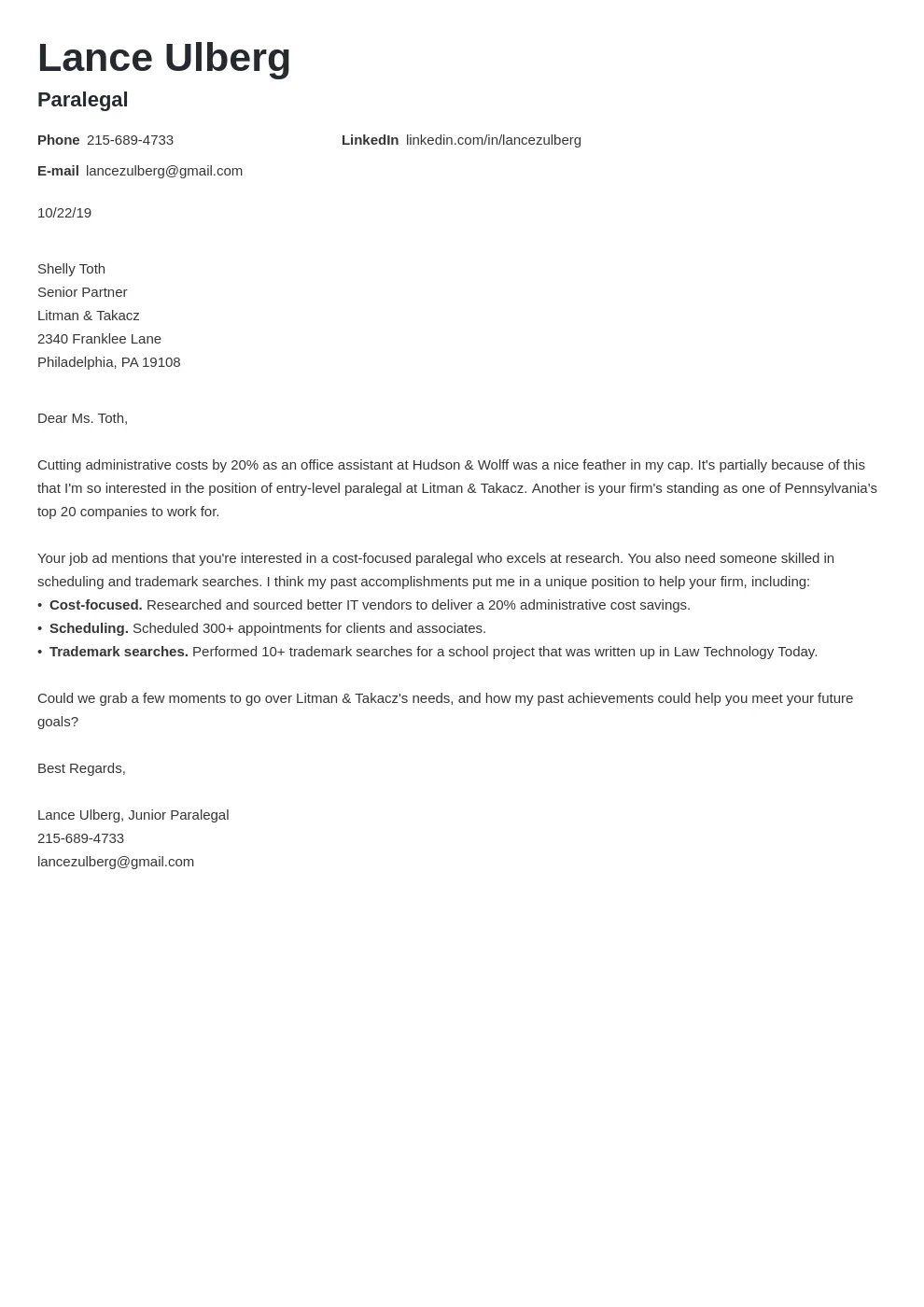
Before writing your cover letter, research the law firm thoroughly. Visit their website, read about their areas of practice, and learn about their mission and values. Identify any recent news or accomplishments that you can mention in your letter to show your knowledge and interest. If possible, research the hiring manager or any members of the team. The information gathered can help you tailor your cover letter, demonstrating that you are genuinely interested in the specific opportunity. Demonstrating that you have done your homework highlights your professionalism and makes a good impression. Showing the hiring manager you have invested the time to research the firm shows how interested you are in the position.
Closing and Formatting
The closing paragraph and formatting of your paralegal cover letter are just as important as the body. The closing paragraph should reiterate your interest in the position, express gratitude for the opportunity, and include a call to action. Thank the hiring manager for their time and consideration. Conclude by stating that you are available for an interview and provide your contact information if not already included. Proper formatting includes using a professional font, consistent font size, and clear spacing. Proofread your letter carefully for any errors in grammar or spelling. A well-formatted and polished cover letter leaves a positive and professional impression. Paying attention to details ensures that your letter is easy to read and reflects your professionalism.
Professional Closing
The closing of your cover letter should be professional and courteous. Use a formal closing, such as ‘Sincerely,’ ‘Respectfully,’ or ‘Best regards.’ Follow this with a comma and then your typed name. Leave space for your signature above your typed name if you are submitting a physical copy. After the closing, reiterate your interest in the position and express your gratitude for the hiring manager’s time and consideration. Finally, include a call to action, stating that you are available for an interview and look forward to discussing your qualifications further. A professional closing reinforces the professional tone of your letter. The goal is to leave a positive impression on the reader and make it easy for them to contact you.
Proper Formatting
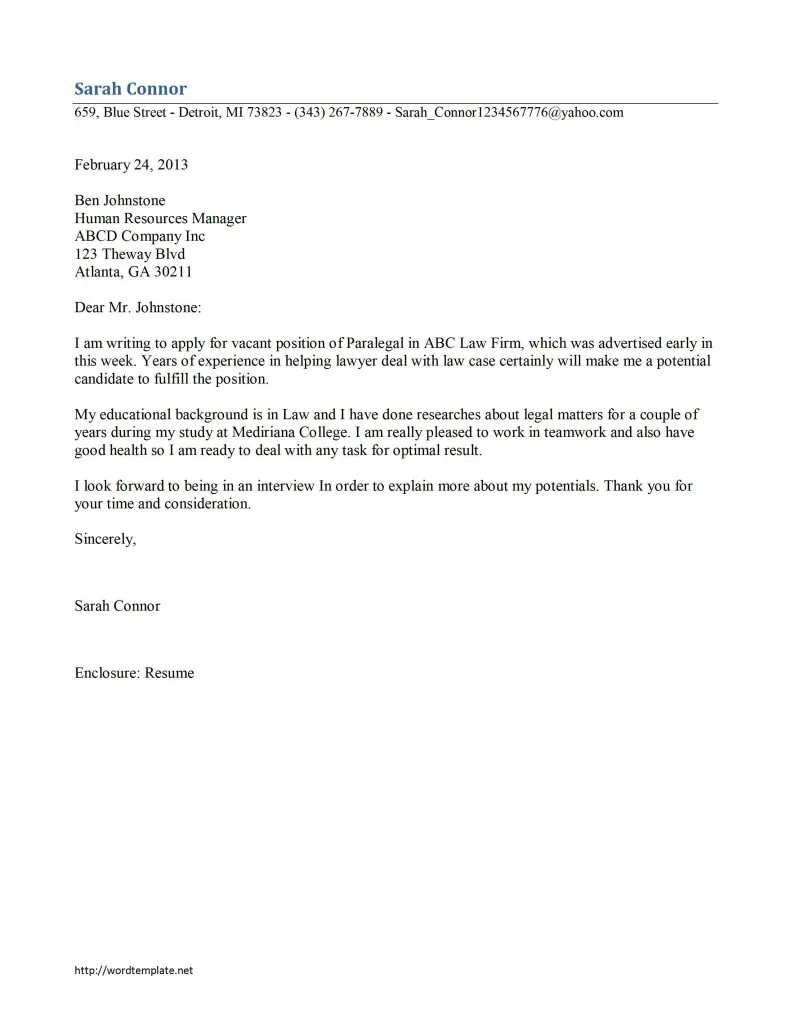
Proper formatting is essential for ensuring your cover letter is easy to read and visually appealing. Use a professional font, such as Arial, Times New Roman, or Calibri, and maintain a consistent font size (typically 10-12 points) throughout the entire document. Use single spacing within paragraphs and double spacing between paragraphs. Align your text to the left, and use a standard one-inch margin on all sides of the page. Avoid using excessive formatting or distracting elements. Use bolding and italics sparingly to highlight key information. Correct formatting makes your letter easy to read and showcases your attention to detail. Use formatting to make your key information easy to spot.
Proofreading and Editing
Before submitting your cover letter, carefully proofread and edit it to eliminate any errors in grammar, spelling, and punctuation. Read your letter multiple times, and consider reading it aloud to catch any awkward phrasing or sentences. Check for clarity, conciseness, and flow, ensuring that your message is easy to understand. Ask a friend or colleague to review your letter as a fresh pair of eyes can often spot errors that you may have missed. Correcting errors demonstrates professionalism and attention to detail, which are crucial for paralegal positions. Proofreading is the final step in the process. Ensure the quality of your cover letter before sending it to employers.
Common Mistakes to Avoid
Avoiding common mistakes can significantly improve the effectiveness of your paralegal cover letter. These mistakes often make a negative impression on hiring managers and can decrease your chances of getting an interview. Some of the most common errors include using generic content, making typos and grammatical errors, and writing lengthy cover letters. By being aware of these pitfalls and taking steps to avoid them, you can create a cover letter that effectively showcases your qualifications and increases your chances of landing the job. Paying attention to detail is critical for all paralegals. The paralegal field is one that needs someone who pays close attention to every detail.
Generic Content
One of the most common mistakes is using generic content in your cover letter. Avoid using a template that you have not tailored to the specific job and law firm. Your cover letter should be unique and reflect your skills and experience. Generic cover letters lack originality and fail to demonstrate your interest in the specific position. When creating your cover letter, take the time to research the employer, tailor your letter to the job requirements, and showcase how your skills and experience align with their needs. This shows the hiring manager you are genuinely interested and have taken the time to customize your application. This will demonstrate a personalized approach to your application.
Typos and Grammatical Errors
Typos and grammatical errors can damage your credibility and undermine the professionalism of your cover letter. Before submitting your letter, carefully proofread it to eliminate any errors in spelling, grammar, and punctuation. Read your letter multiple times, and consider reading it aloud to catch any awkward phrasing or sentences. Ask a friend or colleague to review your letter, as a fresh pair of eyes can often spot errors that you may have missed. Attention to detail is crucial in the legal field, so ensure your letter is polished and error-free. Proofreading is a critical step in the writing process. Errors show a lack of attention to detail and can make a negative impression.
Lengthy Cover Letters
Keep your cover letter concise and focused. Hiring managers are busy and may not have time to read lengthy letters. Aim for a cover letter that is one page long. Focus on the most relevant skills, experience, and qualifications that align with the job description. Avoid including unnecessary details or lengthy explanations. Clearly and concisely convey your message to ensure it is well-received. Lengthy cover letters can lead to the reader losing interest. Make every word count by focusing on essential information. Keeping your letter to one page shows respect for the reader’s time.
Tailoring Your Paralegal Cover Letter
Tailoring your paralegal cover letter is crucial for making a positive impression on potential employers. Each job application should be unique, reflecting your understanding of the specific role and the needs of the law firm. Start by researching the employer, identifying the key requirements and skills they are seeking. Then, carefully review the job description, highlighting the most important qualifications. Use this information to tailor your cover letter, showcasing how your skills and experience align with the job requirements. Provide specific examples that demonstrate your ability to perform the required tasks. Tailoring your letter shows that you have taken the time to understand the position and are genuinely interested in the opportunity. Tailoring your letter is a crucial step to land an interview.
Researching the Employer
Before writing your cover letter, research the employer thoroughly. Visit their website, review their practice areas, and learn about their mission and values. Search for recent news or accomplishments that you can mention in your letter to show that you are informed and interested. If possible, research the hiring manager or any members of the team. Gaining an understanding of their background and interests can also help you tailor your letter. Demonstrate your knowledge of the firm and a strong interest in the position by showing the effort that has been put in. Researching the employer shows you have taken the time to understand the company and their needs. Understanding what the employer is looking for can help you make your cover letter stand out from others.
Matching Skills to Job Requirements
Carefully review the job description and identify the key skills and qualifications the employer is seeking. Use these requirements as a guide when tailoring your cover letter. Highlight your skills and experiences that directly align with the job requirements, providing specific examples of how you’ve utilized those skills in the past. For example, if the job requires strong organizational skills, describe situations where you successfully managed multiple tasks, met deadlines, and maintained a high level of accuracy. If the position requires experience in a particular area of law, highlight your relevant experience and any specialized knowledge. Matching your skills to the job requirements demonstrates that you understand the role and are well-suited to perform the required tasks. It is essential to connect your skills with the required duties outlined in the job description.
Reviewing Paralegal Cover Letter Examples
Reviewing paralegal cover letter examples can provide valuable insights into effective writing techniques and formatting. Search online for examples that are tailored to paralegal positions and specific areas of law. Pay attention to how the authors introduce themselves, highlight their skills and experience, and express their enthusiasm for the role. Analyze the structure, tone, and content of the examples to learn from their approach. However, it is crucial to use examples as inspiration rather than copying them. Your cover letter should be original and reflect your unique skills and experience. You can also seek feedback from career counselors or mentors. Understanding how to write a cover letter helps you showcase your abilities. Remember that your cover letter should reflect your individual skills and experience.
